
To draw:
a) Lewis structure for hydrogen isocyanide (HNC) and assign formal charges to each atom.
b) Explain how the formal charges on atoms differ in the Lewis structures for HCN and HNC.
Answer to Problem 4.117QA
Solution:
a) A Lewis structure for HNC is
![]()
b) The formal charges for each of the atoms in HNC are
| Atom | Formal Charge |
| H | 0 |
| N | 1+ |
| C | 1- |
A comparison of formal charges in Lewis structures for HCN and HNC is given below. Atoms in HCN all have zero formal charge, while the carbon atom in HNC has a formal charge of -1, in spite of having lower electronegativity.
| Atom | Formal Charges in | |
| HNC | HCN | |
| H | 0 | 0 |
| N | 1+ | 0 |
| C | 1- | 0 |
Explanation of Solution
1) Formula: The formal charge on an atom in a molecule is calculated using the following formula.
2) Calculations:
a) The electronic configuration of the elements H, N and C is as follows.
H: 1s1
C: 1s2 2s2 2p2
N: 1s2 2s2 2p3
| Element | Valence electrons | ||
| Symbol | # of atoms | In one atom | Total |
| H | 1 | 1 | 1 |
| C | 1 | 4 | 4 |
| N | 1 | 5 | 5 |
| Valence electrons in molecule | 10 | ||
The skeletal structure of the molecule HNC is
![]()
There are two bond pairs. Therefore 2 x 2 = 4 electrons get utilized in bond formation. Now we put the remaining electrons as lone pairs
![]()
To complete octet of N we will convert some of the lone pairs on C into bond pairs.
A Lewis structure for HNC is as follows.
![]()
Based on this Lewis structure, the formal charges on the atoms can be calculated as follows.
b) The skeletal structure of the molecule HCN is
![]()
There are two bond pairs. Therefore 2 x 2 = 4 electrons get utilized in bond formation. Now we put the remaining electrons as lone pairs
![]()
To complete octet of C we will convert some of the lone pairs on N into bond pairs.
A Lewis structure for HCN is as follows.
![]()
Based on this Lewis structure, the formal charges on the atoms can be calculated as follows.
The Lewis structure of HCN is as follows.
![]()
Conclusion: Thus, atoms in HCN all have zero formal charge, while the carbon atom in HNC has a formal charge of -1, in spite of having lower electronegativity.
Want to see more full solutions like this?
Chapter 4 Solutions
Chemistry: An Atoms-Focused Approach
 ChemistryChemistryISBN:9781305957404Author:Steven S. Zumdahl, Susan A. Zumdahl, Donald J. DeCostePublisher:Cengage Learning
ChemistryChemistryISBN:9781305957404Author:Steven S. Zumdahl, Susan A. Zumdahl, Donald J. DeCostePublisher:Cengage Learning ChemistryChemistryISBN:9781259911156Author:Raymond Chang Dr., Jason Overby ProfessorPublisher:McGraw-Hill Education
ChemistryChemistryISBN:9781259911156Author:Raymond Chang Dr., Jason Overby ProfessorPublisher:McGraw-Hill Education Principles of Instrumental AnalysisChemistryISBN:9781305577213Author:Douglas A. Skoog, F. James Holler, Stanley R. CrouchPublisher:Cengage Learning
Principles of Instrumental AnalysisChemistryISBN:9781305577213Author:Douglas A. Skoog, F. James Holler, Stanley R. CrouchPublisher:Cengage Learning Organic ChemistryChemistryISBN:9780078021558Author:Janice Gorzynski Smith Dr.Publisher:McGraw-Hill Education
Organic ChemistryChemistryISBN:9780078021558Author:Janice Gorzynski Smith Dr.Publisher:McGraw-Hill Education Chemistry: Principles and ReactionsChemistryISBN:9781305079373Author:William L. Masterton, Cecile N. HurleyPublisher:Cengage Learning
Chemistry: Principles and ReactionsChemistryISBN:9781305079373Author:William L. Masterton, Cecile N. HurleyPublisher:Cengage Learning Elementary Principles of Chemical Processes, Bind...ChemistryISBN:9781118431221Author:Richard M. Felder, Ronald W. Rousseau, Lisa G. BullardPublisher:WILEY
Elementary Principles of Chemical Processes, Bind...ChemistryISBN:9781118431221Author:Richard M. Felder, Ronald W. Rousseau, Lisa G. BullardPublisher:WILEY





